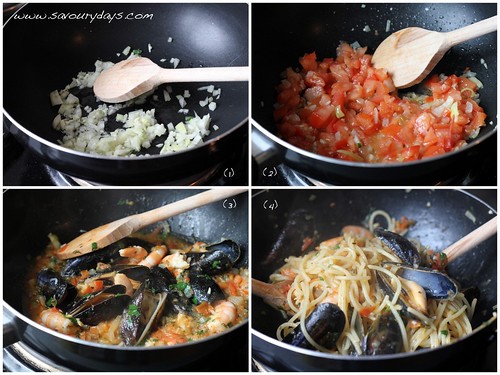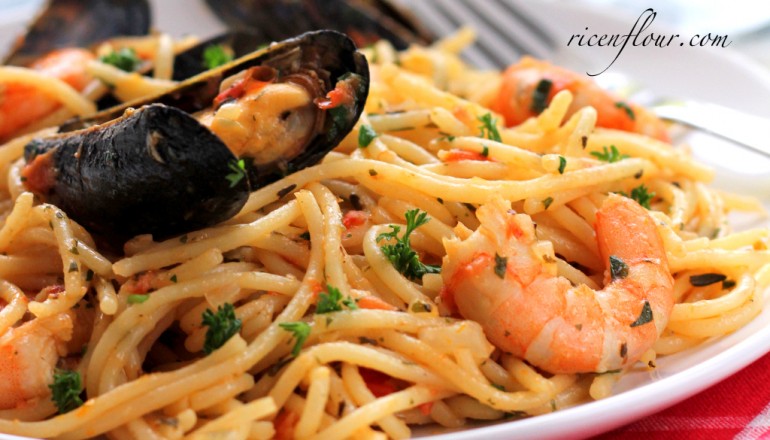To the Vietnamese people, Bolognese pasta, Carbonara pasta and Spaghetti al Frutti di Mare (or Seafood spaghetti) are probably the three most common types of pasta, which are offered in Italian restaurants. Compared to the other two, I personally prefer Frutti di Mare much more since it does not take as much time to cook as Bolognese sauce and is healthier with a lot less fat than Carbonara.
A fun fact, Frutti di Mare literally translates to ‘Fruit of the Sea’. Therefore, the key thing about this recipe is the freshness and the quality of the seafood, especially the mussels, because it is the mussels and the juice they produce while cooking that bring the flavour of the sea into your pasta plate.
Italian cuisine uses mostly herbs as seasoning, and a pinch of herbs goes a long way. You can buy Italian dried mixed herb seasonings to save time and efforts, but for a dish as simple as this one, you want to let the ingredients sing, so try to follow the recipe as closely as possible for the best results. I find that flat-leaf parsley and thyme are the most crucial complement to this beautiful Frutti di Mare.

Spaghetti al Frutti di Mare (Seafood Spaghetti Recipe)
INGREDIENTS
- pasta for 2 people (any types and shapes, but spaghetti or linguine is highly recommended)
- 100 grams shrimp – remove shells and de-vein, wash and pat dry
- 100 grams squid – wash and slice
- 300 grams mussels – cleaned
- ½ onion – diced
- 1 finely chopped garlic clove
- 1 handful of flat-leaf parsley – finely chopped (or substitute with 1 tsp dried parsley)
- 1 handful of chopped basil – finely chopped (or substitute with 1 tsp dried basil)
- 1/8 tsp orange zest
- 3 – 4 sprigs of thyme (or ½ tsp dried thyme)
- 30 ml (2 tbsp) fresh orange juice
- 45 ml (3 tbsp) white wine
- 200 grams canned tomatoes (or fresh tomatoes, remove skin and seeds, finely diced)
- Olive oil
- Salt, pepper
INSTRUCTIONS
1. In a large saucepan, bring water to a rolling boil. Add a pinch of salt, most preferably sea salt. Place all of the pasta into the saucepan and let it gradually sink into the water. When all the pasta finally softens and becomes submerged, stir the pasta gently a few times so that the pasta doesn’t stick to each other or to the bottom of the saucepan.
Follow the instruction on the package to adjust the heat accordingly, but drain the pasta when it is al dente – that is, take it out one or two minutes shorter than the time said on the packaging, as the pasta will continue to be cooked later on the pan. Mix the drained pasta with a spoon of olive oil to prevent the pasta from sticking together.
While waiting for the pasta to cook, prepare the seafood pasta sauce:
2. Place a pan onto the stove. Add a spoon of olive oil into the pan, and fry the garlic and onion for about 2 minutes. Add the tomatoes and stir fry with a pinch of salt and pepper for 2 minutes. Add wine, orange juice and zest, parsley, thyme and stir well, season to taste.

3. Add shrimp, squid and mussels into the pan. Stir very well and cover the pan for about 2 minutes until the mussels are cooked and all of their shells open. Stir one more time
4. On medium heat, add the pasta into the pan and mix well so that the pasta is well-coated in the sauce. Season to taste with salt and pepper. Keep cooking until the sauce thickens and the pasta looks smooth and shiny.
5. Place the pasta onto a plate, and garnish with some more fresh parsley.
Spaghetti al Frutti di Marre should have the aroma and the taste of the salty sea water of the Mediterranean. The spaghetti string should be elastic and al dente to the bite.
Serve the pasta fresh out of the pan, with a cold glass of white wine.
—————————————
- Recipe & Photos: Linh Trang
- Written by: Phương Nguyễn
- Edited by: Thảo Đan




absolutely brilliant – buying the thyme (was the hardest thing to find) but don’t add it to the dish – very well explained!